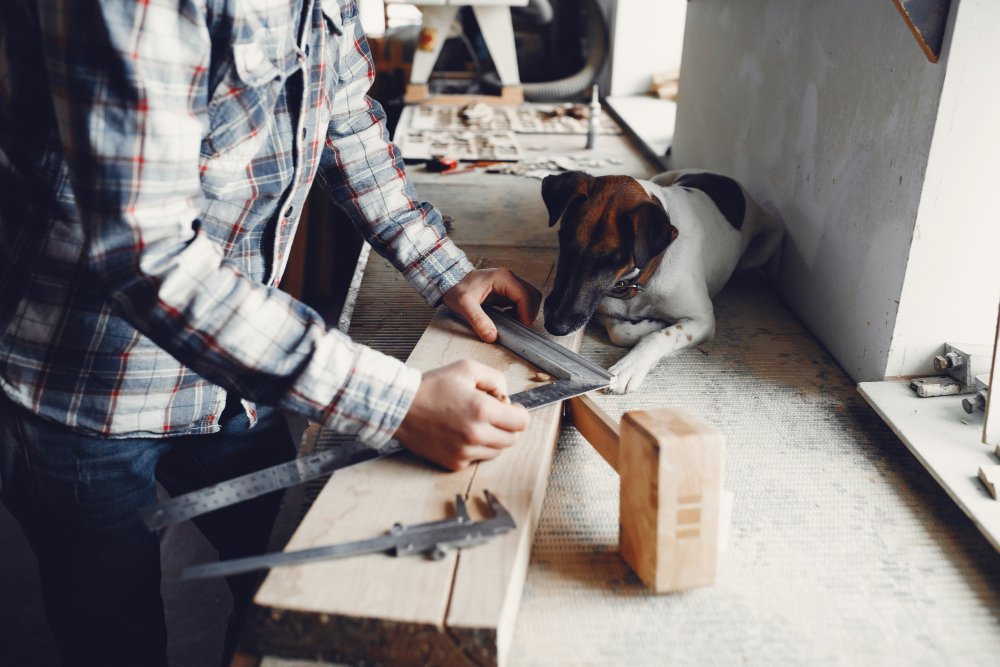Home improvement projects can be an exciting way to refresh your living space, but it’s essential to prioritize the safety of all family members, including your pets. In this article, we will explore how to protect your furry friends from the potential hazards of painting and staining wood furniture. We will also discuss the importance of choosing a pet-friendly wood preserver, the risks associated with apa itu wood stain, and best practices for painting with dogs in the house.
Is Stain Toxic to Dogs?
What Happens If a Dog Eats Stain
If your dog ingests wood stain, it could face serious health risks. Immediate symptoms may include vomiting, diarrhea, lethargy, and difficulty breathing. In severe cases, ingestion of wood stain can lead to liver or kidney failure, neurological issues, or even death.
To prevent your dog from accessing wood stain, always store it in a secure location and maintain a clean work area. If possible, isolate your pet from the project site to minimize the risk of accidental ingestion.
Is Stain Smell Harmful to Dogs?
The fumes from wood stains can be harmful to dogs, causing respiratory irritation, dizziness, or nausea. Prolonged exposure to stain fumes may result in more severe symptoms or long-term health problems.
To minimize your dog’s exposure to stain fumes, ensure proper ventilation by opening windows and using fans. If possible, keep your pets in a separate area of the house during the staining process.
Pet-Friendly Wood Preserver: A Safer Alternative for Your Dogs
Apa Itu Wood Stain and Its Potential Hazards for Pets
Apa itu wood stain? Wood stain is a type of finish applied to wooden surfaces to enhance their appearance and protect them from damage. Unfortunately, many wood stains contain toxic chemicals that can be harmful to pets if ingested or inhaled.
Introduction to Pet-Friendly Wood Preserver
A pet-friendly wood preserver is a safer alternative to traditional wood stains. These products are formulated with non-toxic ingredients to minimize the risks to your pets while still providing the same protective benefits as conventional wood stains.
How to Choose the Right Pet-Friendly Wood Preserver
To select a suitable pet-friendly wood preserver, research the ingredients and look for products labeled as non-toxic or pet-safe. You may also want to consult with a veterinarian or pet safety expert for recommendations. Popular brands that offer pet-friendly wood preservers include Osmo, Rubio Monocoat, and Eco Wood Treatment.
Painting with Dogs in the House: Best Practices for a Safe Environment
Properly Securing and Isolating the Work Area
When painting with dogs in the house, it’s crucial to secure and isolate the work area to prevent accidents. Set up barriers or baby gates to keep your pets away from the project site, and cover any openings where paint or stain fumes could seep through.
Using Non-Toxic Paints and Stains
Choose non-toxic paints and stains whenever possible to reduce the risks to your pets. Look for products labeled as low VOC (volatile organic compounds) or zero VOC, as these emit fewer harmful fumes.
Ensuring Adequate Ventilation and Air Circulation
Proper ventilation is crucial when painting or staining with pets in the house. Open windows and use fans to circulate fresh air throughout the work area and adjacent rooms. This will help dissipate fumes more quickly and reduce the risk of respiratory issues for your pets.
Monitoring Your Pets During and After the Project
Keep a close eye on your pets while painting and staining wood furniture to ensure they don’t come into contact with any hazardous materials. Once the project is complete, continue to monitor your pets for any signs of distress or illness related to paint or stain exposure. If you notice any concerning symptoms, contact your veterinarian immediately.
Dogs and Paint: The Importance of Knowing the Ingredients
Common Chemicals in Paints and Stains That Are Harmful to Dogs
When it comes to dogs and paint, it’s essential to know which ingredients can pose a threat to your furry friends. Some harmful chemicals commonly found in paints and stains include:
- Volatile organic compounds (VOCs): These compounds evaporate at room temperature and can cause respiratory irritation, headaches, or dizziness in dogs.
- Formaldehyde: A known carcinogen that can also cause respiratory issues and skin irritation in pets.
- Glycol ethers: These chemicals can lead to anemia, kidney damage, or neurological issues in dogs if ingested or inhaled.
- Ethylene glycol: A toxic ingredient found in some paints and stains that can cause kidney failure or death in dogs.
Recognizing the Signs of Paint or Stain Poisoning in Dogs
If your dog has been exposed to toxic chemicals in paint or stain, it may exhibit symptoms such as:
- Vomiting or diarrhea
- Lethargy or weakness
- Difficulty breathing or increased respiratory rate
- Loss of appetite
- Excessive drooling or foaming at the mouth
- Seizures or tremors
What to Do If Your Dog Is Exposed to Toxic Chemicals
If you suspect that your dog has been exposed to toxic chemicals in paint or stain, take the following steps:
- Remove your dog from the source of exposure and move them to a well-ventilated area.
- If your dog ingested the paint or stain, do not induce vomiting unless instructed to do so by a veterinarian.
- Contact your veterinarian or an emergency animal clinic immediately to discuss the situation and determine the best course of action.
- Keep the paint or stain container on hand to provide information about the product’s ingredients to the veterinarian.
Conclusion
In conclusion, it’s crucial to prioritize the well-being of your pets during home improvement projects involving painting and staining wood furniture. By choosing a pet-friendly wood preserver, securing and isolating the work area, ensuring proper ventilation, and being aware of the potential hazards associated with dogs and paint, you can create a safer environment for your furry friends. Always remember that the health and happiness of your pets should be a top priority in any home improvement endeavor.

